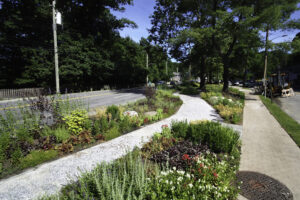
Burns Patterson, a tourism and public relations specialist with strong ties to the region, was recently named executive director of Historic Hudson River Towns.
HHRT is a consortium of riverfront municipalities on both sides of the Hudson focused on tourism promotion, community advocacy, waterfront redevelopment and downtown revitalization.
Patterson replaces Nancy Gold who retired after leading the non-profit since its founding in 1995.
The New York City native moved to Ossining more than 25 years ago and now lives with his wife, Ruth Riordan, in Sleepy Hollow.
Here’s a Q&A with Patterson about what the future holds for attracting visitors to the River Towns.
River Journal: Can you share any plans you have in mind for promoting tourism here?
Patterson: We want to extend and enhance the great relationship we have with the New York State Thruway Authority regarding free audio tours of the biking and walking path of the Mario M. Cuomo Bridge, as well as free tours of the bridge “landing communities” in Irvington, Tarrytown, Sleepy Hollow, Piermont and Nyack. We developed these tours in conjunction with the Thruway Authority and the app developer TravelStorys.
Our team members will be out on the bridge path and in local communities on selected dates to demonstrate the audio tours. Your readers can download the app at travelstorys.com or learn more on our website at hudsonriver.com.
We plan to add a “Living in the Rivertowns” section to hudsonriver.com, which will be a useful resource to prospective homeowners and renters.
We’re exploring a program that can offer discounted installation of electric car charging stations to encourage communities to augment existing stations. Sustainable tourism is the direction we all need to be headed.
River Journal: What are the top attractions in the communities your organization represents?
Patterson: Rockefeller State Park Preserve in Mount Pleasant and the Shared Use Path of the Cuomo Bridge top this list. Prior to the pandemic, the Preserve was seeing about 400,000 visitors per year. By 2021, that volume had exceeded 600,000 visitors – a stunning 50% increase, and the numbers do not seem to be decreasing. The biking and walking path of the Cuomo Bridge has hosted more than 400,000 visitors since 2020. I believe those numbers will continue to climb as more people discover the amazing views of the path and its overlooks.
Other “indoor” sites have suffered during the pandemic, but we’re thrilled to see sites such as Kykuit, the Rockefeller estate, open again for the summer and fall of 2022 after a two-year hiatus.
River Journal: Can you share a few of your personal favorites that are not among the top attractions?
Patterson: When I was a kid, a low-cost way to get out on the water was to take the Staten Island Ferry round-trip. The NY Waterway Ferry between Ossining and Haverstraw runs weekdays during commuter hours morning and evening, but it’s not just for commuters! The ferry runs across a gorgeous stretch of the Hudson and offers a great “mini-cruise” if taken round-trip, or offers access to great dining spots at either landing site.
In Haverstraw, another hidden gem would have to be the Haverstraw Brick Museum. In Westchester I’d add the Armour-Stiner Octagon House in Irvington as a “hidden gem,” Untermyer Gardens in Yonkers, and even the Old Croton Aqueduct.
River Journal: Malls and retailers are struggling against online sellers, and are pivoting toward go-and-do destinations instead of shopping. What do you and HHRT envision as the key factors in ensuring long-term growth and viability for our small downtowns?
Patterson: Keeping the “river” top of mind in the “river towns” is one of the most important aspects of long-term growth for these downtowns. That means continuing to expand public waterfront access and linking existing Riverwalks. That means being creative with mixed-use development of former industrial sites that can offer public access while also activating the waterfront. That means encouraging walkable or bike-safe access for visitors and local residents. That also means protecting the Hudson River itself, whether through increased investment in storm drain and sanitary infrastructure or other means.
I also think it’s vital to expand hotel capacity in the region, hopefully with the addition of hotels along the waterfront – which has been a missing element for years. Several development projects along the river are working to include hospitality investment.
River Journal: Where are the visitors to the River Towns coming from, and how much do they spend? Where does HHRT get this data?
Patterson: We depend on Visit Westchester and Visit Rockland for data. Visit Westchester’s most recent data, even accounting for reduced travel during the pandemic, highlights more than $1.15 billion in 2020 visitor spending in the county. It’s important to note that after years of growth, however, that figure was down nearly 43% from its peak in 2019. So, all of us in the tourism community have our work cut out for us to rebuild visitor numbers.
The Rockland Office of Economic Development and Tourism relayed data from Empire State Development noting that the Hudson Valley region ranks third of all state regions, trailing only New York City and Long Island, in terms of visitor spending.
Visitors from New York City and the tri-state region make up the lion’s share of visitors and we need to continue to cultivate that market.
However, I’m also struck by the fact that within Westchester, local residents from the Sound Shore don’t always explore the River Towns (and the same in the other direction). Even village to village, on both sides of the river, residents aren’t always aware of nearby amenities. I think there’s an opportunity to encourage local residents to explore their own nearby communities.
Note: This interview has been edited for length and clarity. Visit www.hudsonriver.com for more information about HHRT.






